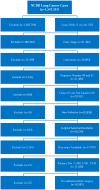Nodal Upstaging Is More Common with Thoracotomy than with VATS During Lobectomy for Early-Stage Lung Cancer: An Analysis from the National Cancer Data Base
- PMID: 26792589
- PMCID: PMC4729646
- DOI: 10.1016/j.jtho.2015.10.007
Nodal Upstaging Is More Common with Thoracotomy than with VATS During Lobectomy for Early-Stage Lung Cancer: An Analysis from the National Cancer Data Base
Abstract
Introduction: Questions remain regarding differences in nodal evaluation and upstaging between thoracotomy (open) and video-assisted thoracic surgery (VATS) approaches to lobectomy for early-stage lung cancer. Potential differences in nodal staging based on operative approach remain the final significant barrier to widespread adoption of VATS lobectomy. The current study examines differences in nodal staging between open and VATS lobectomy.
Methods: The National Cancer Data Base was queried for patients with clinical stage T2N0M0 or lower lung cancer who underwent lobectomy in 2010-2011. Propensity score matching was performed to compare the rate of nodal upstaging in VATS with that in open approaches. Additional subgroup analysis was performed to assess whether rates of upstaging differed by specific clinical setting.
Results: A total of 16,983 lobectomies were analyzed; 4935 (29.1%) were performed using VATS. Nodal upstaging was more frequent in the open group (12.8% versus 10.3%; p < 0.001). In 4437 matched pairs, nodal upstaging remained more common for open approaches. For a subgroup of patients who had seven lymph or more nodes examined, propensity matching revealed that nodal upstaging remained more common after an open approach than after VATS (14.0% versus 12.1%; p = 0.03). For patients who were treated in an academic/research facility, however, the difference in nodal upstaging between an open and VATS approach was no longer significant (12.2% versus 10.5%, p = 0.08).
Conclusions: For early-stage lung cancer, nodal upstaging was observed more frequently with thoracotomy than with VATS. However, nodal upstaging appears to be affected by facility type, which may be a surrogate for expertise in minimally invasive surgical procedures.
Keywords: Lobectomy; Lung cancer surgery; Staging; Video-assisted thoracic surgery (VATS).
Copyright © 2015 International Association for the Study of Lung Cancer. Published by Elsevier Inc. All rights reserved.
Figures
Comment in
-
Location of the Tumor is a "Central" Predictor of Nodal (N1) Upstaging.J Thorac Oncol. 2016 Jul;11(7):e89-90. doi: 10.1016/j.jtho.2016.02.022. J Thorac Oncol. 2016. PMID: 27339413 No abstract available.
-
Nodal Upstaging: "Confounded" by Tumor Location?J Thorac Oncol. 2016 Jul;11(7):e90-1. doi: 10.1016/j.jtho.2016.04.008. J Thorac Oncol. 2016. PMID: 27339414 No abstract available.
-
On the Article "Nodal Upstaging Is More Common with Thoracotomy Than with VATS during Lobectomy for Early-Stage Lung Cancer: An Analysis from the National Cancer Data Base" by Medbery et al.J Thorac Oncol. 2016 Aug;11(8):e103-e104. doi: 10.1016/j.jtho.2016.04.034. J Thorac Oncol. 2016. PMID: 27453165 No abstract available.
-
Location, Location, Location: The Reality of Tumor Real Estate and Nodal Upstaging.J Thorac Oncol. 2016 Aug;11(8):e104. doi: 10.1016/j.jtho.2016.05.015. J Thorac Oncol. 2016. PMID: 27453166 No abstract available.
References
-
- McKenna RJ, Jr, Houck W, Fuller CB. Video-assisted thoracic surgery lobectomy: experience with 1,100 cases. The Annals of thoracic surgery. 2006;81:421–5. discussion 5-6. - PubMed
-
- Paul S, Altorki NK, Sheng S, et al. Thoracoscopic lobectomy is associated with lower morbidity than open lobectomy: a propensity-matched analysis from the STS database. The Journal of thoracic and cardiovascular surgery. 2010;139:366–78. - PubMed
-
- Swanson SJ, Herndon JE, 2nd, D'Amico TA, et al. Video-assisted thoracic surgery lobectomy: report of CALGB 39802--a prospective, multi-institution feasibility study. Journal of clinical oncology : official journal of the American Society of Clinical Oncology. 2007;25:4993–7. - PubMed
-
- Cattaneo SM, Park BJ, Wilton AS, et al. Use of video-assisted thoracic surgery for lobectomy in the elderly results in fewer complications. The Annals of thoracic surgery. 2008;85:231–5. discussion 5-6. - PubMed
Publication types
MeSH terms
Grants and funding
LinkOut - more resources
Full Text Sources
Other Literature Sources
Medical


